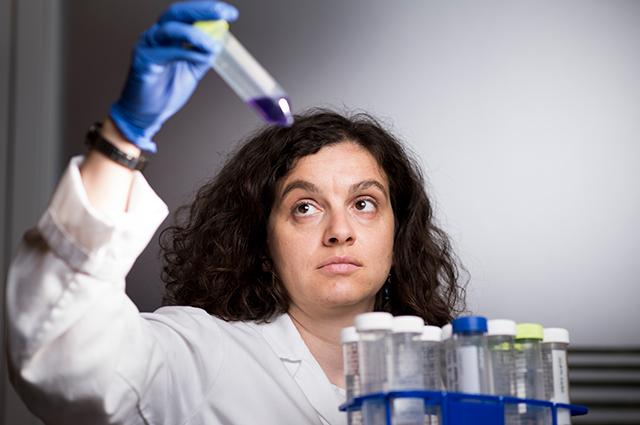-
About
- Departments & Offices
-
Academics
- Physician Assistant
- Special Master’s (MBS)
-
Admissions & Financial Aid
- Tuition & Fees
-
Student Life
-
Research
- Research Labs & Centers
-
Local & Global Engagement
- Global Health Program
The Coronavirus Sneaks Its Way into Cells. But How?
Marta Gaglia studies the way viruses infiltrate the body without tripping the immune system’s alarms

In Spring 2020, as the world watched the novel coronavirus spread across the globe, Marta Gaglia, an assistant professor of molecular biology and microbiology at Tufts University School of Medicine, had a realization: The very same approaches she had been using to study familiar viruses like influenza and herpes could be applied to SARS-CoV-2, the virus that causes COVID-19.
“What my lab works on is what happens when viruses get into cells—how do viruses prevent cells from recognizing that they’re infected and mounting an immune response?” Gaglia explains.
To answer this question, Gaglia studies proteins in a virus that block a cell from signaling the presence of an intruder, tamping down the cell’s immune response so that the virus can replicate. In the context of SARS-CoV-2, this lack of immune response is what allows a COVID-19 infection to take hold.
Now, with funding from the American Lung Association’s COVID-19 and Emerging Respiratory Viruses Research Award, as well as seed funding from Marie Rozan, M64, J93P, A95P, Gaglia is investigating viral proteins that are key to this process. She is working with Jonathan Runstadler, a professor in Cummings School of Veterinary Medicine.
“We want to identify these proteins and figure out how they work on a very basic level,” Gaglia says. To do this, the team will infect cell lines and lung tissue models with versions of SARS-CoV-2 that are missing different proteins and look at the resulting immune responses in the infected cells.
And while Gaglia’s research focuses on the fundamental science of SARS-CoV-2, it could have important applications down the line. “The idea would be to know more of what's going on with the immune response beyond ‘something is wrong’ so there’s more of a chance to figure out how to fix it or redirect it,” Gaglia says—for example, by treating patients with anti-inflammatory drugs. Learning how these proteins work will also allow scientists to explore their potential as drug targets.
“The infection is the interaction between the virus and the host, so understanding this interface is really important for us to develop a more comprehensive way to target viruses,” she explains.
Department:
Molecular Biology and Microbiology